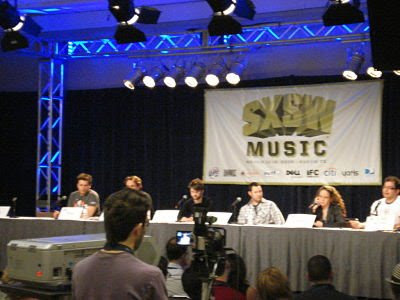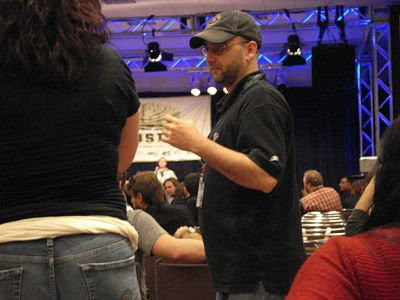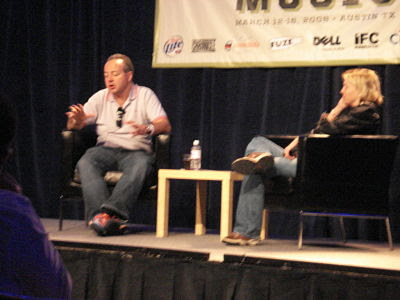
Call me a glutton for punishment…the Interactive Conference concluded on Tuesday, but I was back at the Convention Center on Wed. for the opening of the Music portion. Two panels peaked my interest. The Best Online Resources for Musicians included a power panel of social media execs, folks from MySpace, SonicBids, YouTube, Bebo, Last.fm, and iLike. Brad King, who teaches at Northern Kentucky University was the moderator. This is fascinating to me, both from a teaching perspective, and because many of my friends are musicians looking to use these tools to advance their careers.
The SonicBids person (Panos Panay) was particularly eloquent in saying that its not just the music business that musicians must understand, it is also the online business. In a new band, he recommended that someone in the group be designated as in charge of learning all there is to know about online options.
The panel discussed the concept of “life streaming,” which is not the same as live streaming. It’s about engaging the social media community to promote your band, your fans can do it for you, if you just give them the tools.
And, I thought it was quite important that the panel discussed the positive opportunities that this environment now provides, downplaying all the negativity about free music. There’s more than one track that a musical act can take now. Getting signed by a giant label was very lucrative, but only available to a few. Now musicians can take their careers down a variety of tracks. It reminds me of how in Austin, people can be working musicians, because there’s an infrastructure here that supports it. Some of them may never be massively famous, some of them don’t even want that, but they can pursue their passion for music as a career. Now, those opportunities are broader.
The next panel featured Rob Glaser of RealNetworks, who also owns Rhapsody, the digital music service, interviewed by Tamara Conniff of Billboard. RealNetworks has been around since 1994, pioneers in the music player and streaming environment. I think the most interesting aspect of this presentation was his description of the three models for digital music and his prediction that they will coexist.
- Free Streaming with advertising
- Subscription
- Pay
My take, however, is that he missed some of the opportunity described by the previous panel. When talking about the need some people have to express themselves via their music libraries of book collections, the new way to do that will be via a social networking site, like Facebook or a music delivery site like Last.fm, that allows you to create an identity via the pop culture in which you engage. It an be fluctuating and dynamic, but all your friends can see with what you are most currently engaging. So, I think he missed the social aspect of the engagement.
Then, it was out to hear some music. I’ll be moving my music experiences to my personal blog at cindyroyal.blogspot.com, so be sure to drop by if you are interested my rock adventures.



Permalink
Very cool….. thanks for sharing. Wish I was there……
Permalink
After the few dozen articles I’ve read lately about a transition to new business models for old media industries like newspapers, I can say with absolute certainty that it’s important, imperative even, for all industries to understand the power of the internet, not just musicians. But, what really interests me is how media industries are starting to capitalize on the idea of “free.”
In a February Wired article, Chris Anderson talks about how the free model, which started with the disposable razor genius, Gillette, is being pulled in a dozen different directions to meet the assorted business needs of different media today. He defines “freeconomics,” and then outlines several variations of working models, and how different media institutions are currently implementing them.
I’ve also been reading a lot about how innovation is a must to rejuvenate aged business models. Free, in and of itself, is nothing new. But how businesses are chosing to incorporate free with new media in their business models to stay afloat or to reach larger audiences is really cool!